
Fig 1. CSA f. 28r. Mt 18:11 is omitted. I thank Father Justin for giving permission to use this image.
Arabic versions of the Bible have been frequently overlooked in New Testament textual criticism because of the belief that the Arabic versions are late and were derived from sources close to the ‘Byzantine’ text, which is the text-form of the majority of manuscripts from the Middle Ages.[1] This supposition can no longer be sustained. A number of Arabic Gospel versions have been shown to be textually significant with many non-Byzantine readings. This is especially the case for one particular version, found almost exclusively in the Sinai New Finds of 1975. In 2008, Hikmat Kashouh published a study of Sinai ar. NF Parch. 8 and 28 (see fig. 1) which he identified having been originally one codex which he dubbed Codex Sinaiticus Arabicus (CSA).[2] Kashouh argued that this version had most likely been translated from a Greek Vorlage and noted 230 variation units where the manuscript preserved a non-Byzantine reading.[3] In 2011, Kashouh published a monograph surveying over 200 Arabic manuscripts of the Gospels and placed them into 24 distinct families, labeled from A to X. Codex Sinaiticus Arabicus was categorised in Family B (hereafter referred to as arb), together with two other manuscripts from the New Finds: Sinai ar. NF Parch. 24 and Sinai ar. NF Parch. 44.[4] I have elsewhere shown that the text of this family is also preserved in other manuscript fragments of these codices as well as in the Arabic Gospel lectionary tradition.[5] For this post, I compare the text of this family with the manuscripts of the Greek tradition using Text und Textwert to further explore how this Arabic version can enhance our understanding of the history of the text of the Gospels.
The four Text und Textwert (TT) volumes for the Gospels collate the variant readings of around 2000 Greek manuscripts at 466 test locations.[6] At each test location, I compared the text of the manuscripts of arb with all attested Greek readings in light of the translation technique of the version.[7] The Greek readings of the TT volumes are placed in one of three classes:[8]
- ‘Majority’ readings i.e. readings which agree with the Byzantine Text.
- ‘Ancient’ readings which represent the earliest recoverable text, which in the TT editions is presumed to be the United Bible Societies (UBS) committee text. Readings from this class can overlap with the previous one when the Majority Text agrees with the UBS reading.
- ‘Special’ readings which disagree with both the Majority and the Ancient readings.
In the graphs below, I present the percentage similarity of the manuscripts with these three classes of readings. This is the number of agreements with readings of this class divided by the total number of unambiguous test locations attested by the manuscript. The TT volumes generally have several sub-variants under each major variant reading. The distinction between the sub-variants is ignored in the analysis below. In addition, at many test locations the different variant readings in Greek could have been translated in the same way in Arabic. The ambiguous locations are excluded from the analysis below as well.
Agreement with the Majority Text
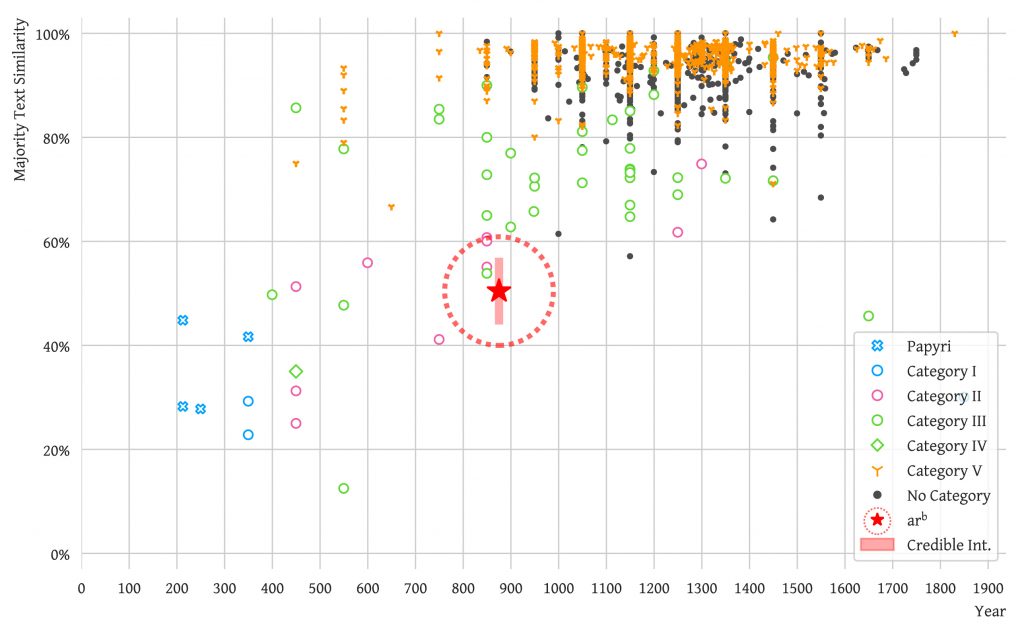
Fig. 2. The similarity of manuscripts with the Majority Text over time. Data are combined across all the test locations used in the Four Gospels. Manuscripts are labeled with the category assigned to them by the Alands.[9] The approximate dates of Greek manuscripts are taken from the Kurzgefasste Liste.[10] For clarity, the only credible interval (expressing the uncertainty of the calculation) shown is for arb. This graph combines data from all four Gospels. The equivalent graphs broken down for all four Gospels are found on my Github page.
The graph above (fig. 2) shows the percentage agreement with the Majority Text against the estimated time the manuscript was written. The trend towards increasing conformity with the Byzantine text is clear. When compared to this trend, the text of Family arb (marked with the star in the dotted circle) is significantly non-Byzantine. Overall across the four Gospels there is an agreement percentage of approximately 50%. This would rank arb at 16th least-Byzantine.[11] When accounting for uncertainty due to the sample size, with a 95% credible interval, the lowest credible rank of arb would be 25th and thus arb would be well within the top 2nd percentile of TT manuscripts in terms of dissimilarity with the Majority Text.[12] It is clear therefore that arb preserves a text with a high proportion of non-Byzantine readings compared to the vast majority of the Greek tradition.
Agreement with the ‘Ancient’ (UBS) Text
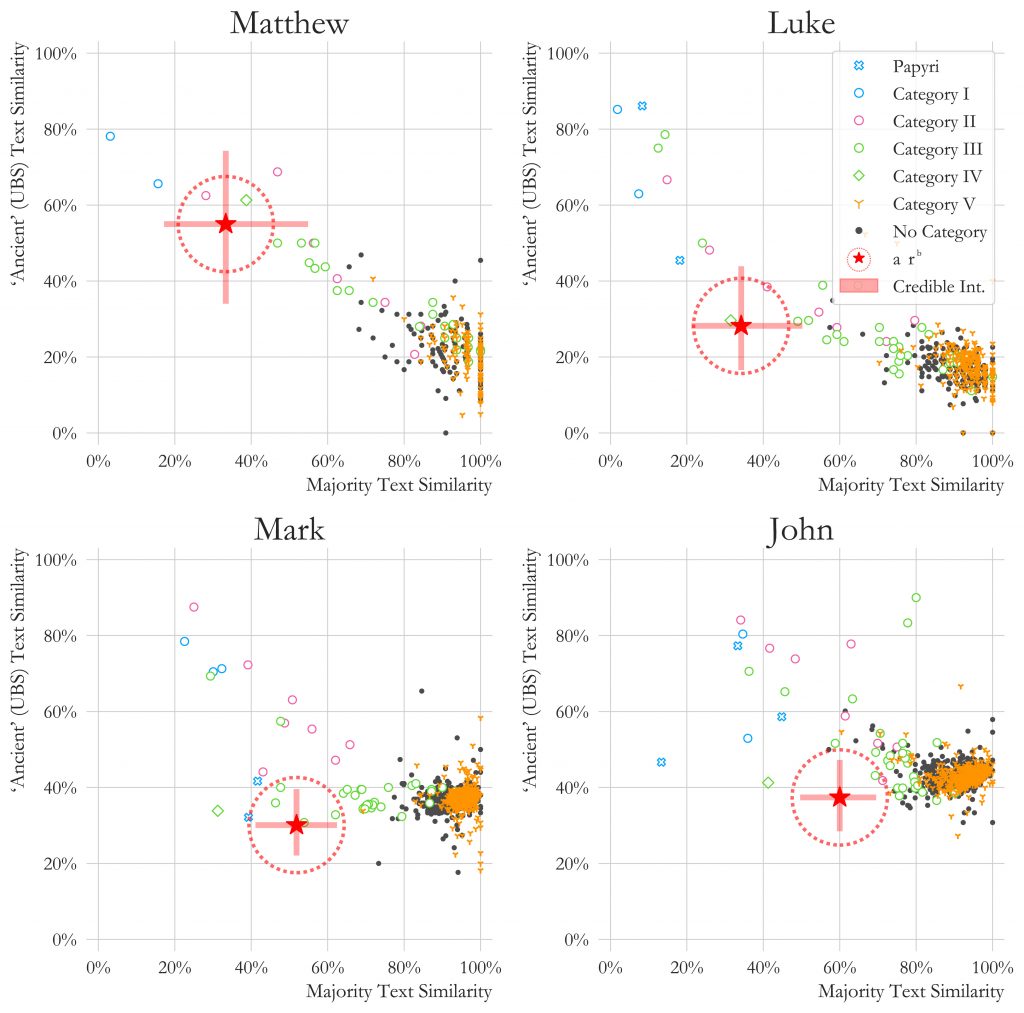
Fig. 3. The similarity with the UBS text against similarity with the Majority Text.
The graph above (fig. 3) shows agreement with the Majority Text (as discussed in the previous section) on the x-axis and with agreement with the Ancient Text on the y-axis. For Matthew, arb is relatively high on the graph compared to the other manuscripts, indicating a strong connection with the Ancient text.[13] Some examples of agreements between arb and the Ancient Text in Matthew are omitting Mt 17:21 and 18:11 (fig. 1) and including the phrase ‘nor the Son’ in Mt 24:36 (fig. 4). However, overall across the four Gospels (particularly in Mark and John), the agreement between arb and the Ancient (UBS) text is relatively low at approximately 35% and below the majority of Greek manuscripts, giving arb a rank of 1576 out of 1900.

Fig. 4. Sinai ar. 71, f. 3v. Originally one codex with Sinai ar. NF Parch 44. It includes the non-Byzantine addition of the words ‘nor the Son’ in Mt 24:36. It shares this reading with CSA. I thank Father Justin for giving permission to use this image.
Special Readings
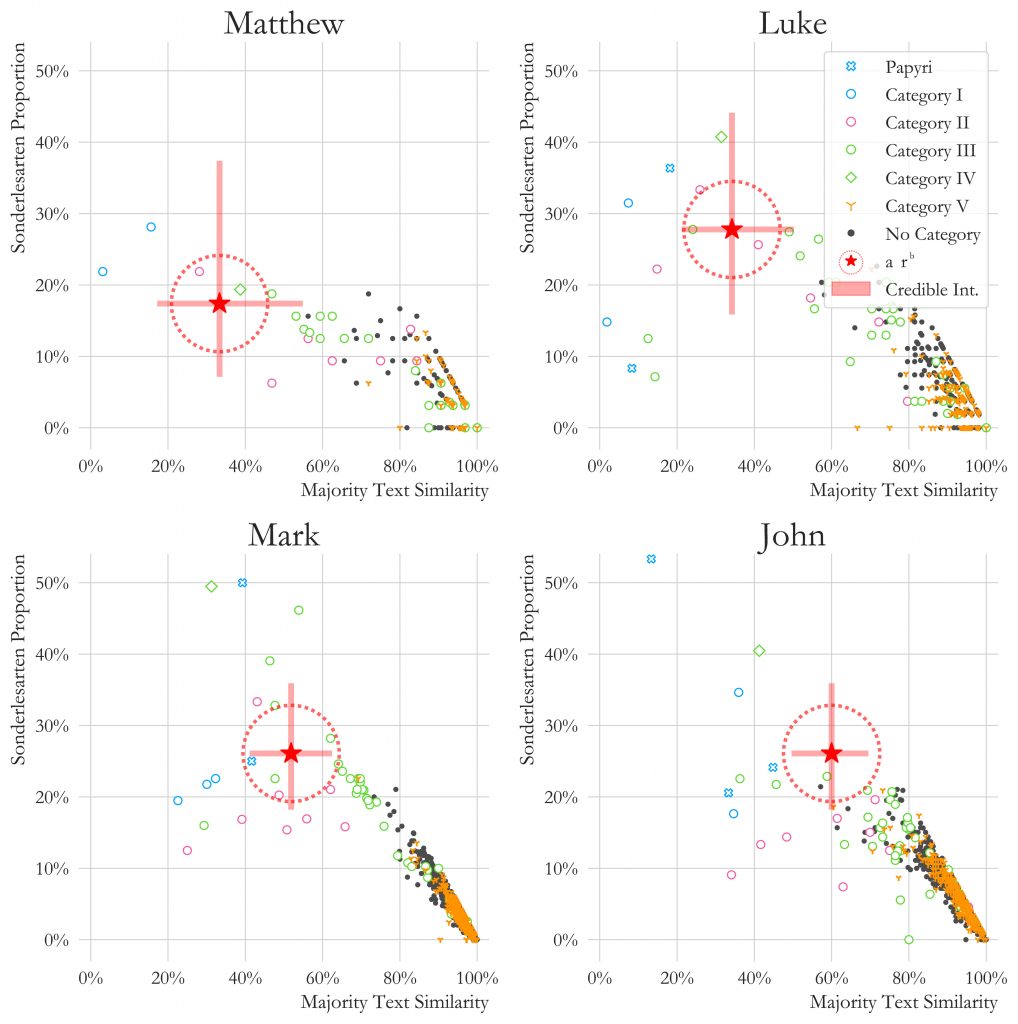
Fig. 5. Proportion of special readings (labelled as Sonderlesarten) against proportion of agreement with the Majority Text.
Since, in general, the agreement with both the Majority Text and the Ancient Text was low, it is no surprise that the number of agreements with ‘Special Readings’ was relatively high when compared against Greek Gospel manuscripts. In the graph above (fig. 5), arb consistently has a higher proportion of special readings when compared with the majority of Greek manuscripts. An example of this is the omission of the words ‘the Son of God’ from Mark 1:1 (see fig. 6).[14] Another example is in John 3:20 where arb adds the special reading: ‘because they are evil’ (see fig. 7). Manuscripts with high proportions of Special Readings are interesting because they have the potential to be helpful in reconstructing the history of transmission of the New Testament for less well preserved branches of the tradition.[15] To truly appreciate how arb sheds light on the history of the transmission of the Gospels in particular, we will need more sophisticated analysis than I can present here but I hope to speak more about the topic with a follow-up post in the future.
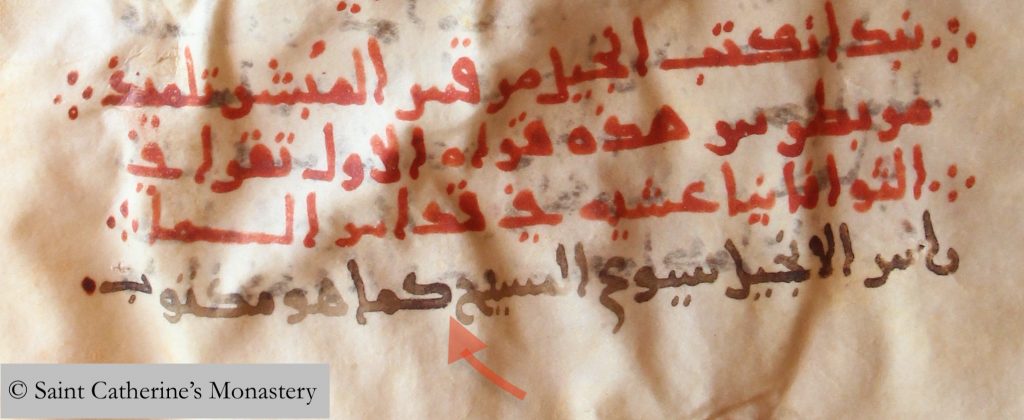
Fig. 6. Sinai ar. NF Parch 36, f. 22v. Originally one codex with Sinai ar. NF Parch 15, 24 and 64. It omits the words ‘the Son of God’ at the end of Mk 1:1. This reading is shared with CSA. I thank Father Justin for giving permission to use this image.
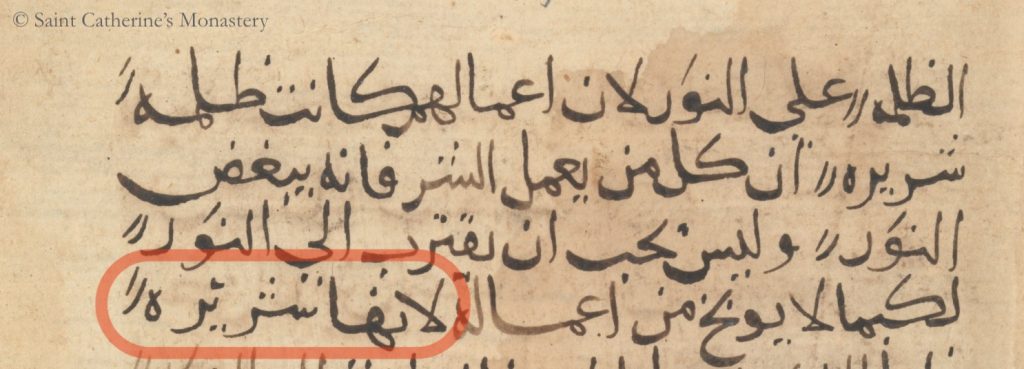
Fig. 7. Sinai ar. 138 f. 17r. A Gospel lectionary showing John 3:20 (for the 2nd Tuesday after Easter). It as the special reading ‘because they are evil’ at the end. It shares this reading with CSA and other lectionaries of this family. I thank Father Justin for giving permission to use this image.
Conclusion
In conclusion, probing the character of Family B of the Arabic Gospels using Text und Textwert gives similar results to Kashouh’s earlier study from Luke. Family B is consistently non-Byzantine throughout the four Gospels and with high credibility would rank together the top 25 manuscripts of the Greek tradition in terms of dissimilarity with the Majority Text. The text of arb in Luke and the latter half of Matthew shows a high proportion of similarity with the ‘Ancient’ (UBS) Text though more test passages are necessary to demonstrate this with greater certainty. In particular, there are a very high number of ‘special’ readings which disagree with both the Majority and Ancient texts. This potentially makes arb of great value in explaining poorly understood branches of the transmission of the Gospels. This Arabic version is of high significance and it would be appropriate for it to be cited in the apparatus of future critical editions of the Gospels. It is hoped that through further study of this version, it can be precisely related to other manuscripts in the Greek tradition to illuminate the history of transmission of the Gospels.
Robert Turnbull is a PhD student working on Arabic manuscripts of the Gospels under the supervision of Alexander Treiger and Michael Bird. This article is an abridged version of his paper at the 11th Birmingham Colloquium on the Textual Criticism of the New Testament in March, 2019. The full version will be available with the conference proceedings volume under the title ‘The Textual Character of Codex Sinaiticus Arabicus and its Family.’
Footnotes
[1] Shahîd, for instance, states that extant Arabic biblical versions are ‘late… and thus have little value for biblical textual criticism.’ Shahîd, Byzantium and the Arabs in the Fourth Century, 443.
[2] Hikmat Kachouh, ‘Sinai Ar. N.F. Parchment 8 and 28: Its Contribution to Textual Criticism of the Gospel of Luke,’ NovT 50.1 (2008): 28–57. NB. In the text, I follow the English spelling of Kashouh’s name from the later publication of his monograph.
[3] Kachouh, ‘Sinai,’ 53–54.
[4] Hikmat Kashouh, The Arabic Versions of the Gospels: The Manuscripts and Their Families (Berlin: De Gruyter, 2011), 96–112.
[5] I’m currently preparing a monograph on the transmission history of this family with a critical edition of the text.
[6] I thank Klaus Wachtel for sharing with me the data for the TT volumes for the Synoptics. I was not able to utilize the data from the TT volume which contains Bruce Morrill’s full collation from John 18. The results of my comparison of arb with TT in John 1–10 was also presented in part in a forthcoming article entitled: ‘Codex Sinaiticus Arabicus and its Family.’
[7] In Matthew, only the last 32 test locations are used in the analysis below due to contamination in Matthew 1–11 from Family D which was translated from the Peshitta.
[8] Kurt Aland and Barbara Aland, The Text of the New Testament: An Introduction to the Critical Editions and to the Theory and Practice of Modern Textual Criticism (Grand Rapids: Eerdmans, 1987), 107, 333–34.
[9] Aland and Aland, Text, 107–40.
[10] Kurt Aland et al., Kurzgefasste Liste der griechischen Handschriften des Neuen Testaments (Berlin: De Gruyter, 1994). Available online: http://ntvmr.uni-muenster.de/liste
[11] When compared with the Greek manuscripts attesting to at least 10 test locations in TT.
[12] Explanation for how I handle the uncertainty is given in the unabridged print version of this article.
[13] The number of unambiguous test-locations in Matthew is only 20 which is a very small sample size.
[14] With the help of Kashouh, Wasserman notes this reading in CSA: Tommy Wasserman, ‘The “Son of God” was in the Beginning (Mark 1:1),’ JTS 62.1 (2011): 20–50, esp. 31. To this, I can add Sinai ar. NF Parch 36 (originally one codex with Sinai ar. NF Parch 15, 24 and 64) also shares this reading.
[15] Using the categories specified by the Alands, arb could appropriately be placed in Category III since it disagrees consistently with both the Byzantine and the ‘Ancient’ texts. The Alands regarded this category as particularly important for uncovering the history of the transmission of the text due to the distinctive character of the readings. Aland and Aland, Text, 106, 159, 335–36.


Haus Beach
Most scholars who prepare an article for printing complain that they had to abridge their work due to word limits, the print edition being shorter. Your print edition is longer!
Robert Turnbull
Hi Haus Beach,
Thanks for your comment. This post is shorter because of the nature of a blog. It needed to be a simpler version for this context.
Rob
James David Audlin
Greetings: I am a New Testament scholar working for nearly 50 years on establishing an approximation of an Urtext of the Gospel of John; for this reason, I hope to see eventually variant readings in the Arabic corpus. (Yes, I read Arabic too.) You may be interested in these comments, from a to-be-published next edition of one of my books:
A very early and reasonably faithful Arabic version of John 15:23-16:1 is found in Ibn Isḥāq’s Kitāb al’Maghāzī, compiled between 754 and 767.
من أبغضني فقد أبغض الرب، ولولا أني صنعت بحضرتهم صنائع لم يصنعها أحد قبلي، ما كانت لهم خطيئة ولكن من الآن بطروا وظنوا أنهم يعزونني، وأيضا للرب ولكن لا بد من أن تتم الكلمة التي في الناموس أنهم أبغضوني مجانا، أي باطلا. فلو قد جاء المنحمنا هذا الذي يرسله الله إليكم من عند الرب وروح القدس هذا الذي من عند الرب خرج فهو شهيد علي وأنتم أيضا; لأنكم قديما كنتم معي في هذا، قلت لكم لكيما لا تشكوا
One who has hated me has hated the Lord, and, if I had not wrought in their presence works which no one had done before me, they would not have sinned. But now they feel that they have been betrayed, and thought they could isolate me, and also God. But the word in the Law must be fulfilled, “They hated me without cause”; that is, falsely. When the mnḥmnā is given to you by the Lord, the sacred spirit who will have come from the Lord, that one will be a witness about me, and you (will witness about me) too, because you were with me in the past. I have told you this so that you will not complain/doubt.
This Arabic version appears reasonably close to the Textus Receptus and the Galilean Aramaic version, which does not notably differ from each other – except in the second sentence in the Arabic, which the Greek in translation has as “but they have both beheld and hated both my father and me.” Jesus is saying if it weren’t for his miracles they would not have committed sin; but his miraculous works have apparently provoked anger, jealousy, and spite, which in turn have pushed them into sin. Also notable is that the word منحمنا (mnḥmnā) exactly transliterates the word that is found in the Palestinian Lectionaries, ܡܢܚܡܢܐ (mnḥmnā), and not what the Syriac texts, or even the Sinaiticus Rescriptus has, which is ܦܪܩܠܝܛܐ (prqlyṭā) a transliteration of the Greek word παρακλητος (paraklētos), translated in turn into English as “Paraclete”. This word منحمنا is lifted up by Muslims as a name for Mohammed, because they believe Mohammed to be the fulfillment of the promise of the Paraclete. Christians generally hold that the Holy Spirit is the result of this promise. For my part, I am interested in what the text was written to say, and thus I note that منحمنا is not merely a transliteration; in the sister tongue of Arabic it means “we are given” or “we have been given”. Put into John 15:26, this meaning gives Ibn Isḥāq’s the sense of “When the ‘we-have-been-given’ has been given to you …”, which is a beautiful tautology.
Sean W. Anthony in “Muhammad, Menahem, and the Paraclete” (Bulletin of SOAS, 79:3 [2016]) argues that Ibn Isḥāq’s source was a Christian Palestinian Aramaic text, but as noted every extant version in that dialect or the Syriac dialect transliterates the Greek. Only the Lectionaries have ܐܢܡܚܢܡ, which they must have taken from a Galilean Aramaic original. Since Ibn Isḥāq transliterates perfectly the Aramaic, and since this passage from John in the mid-eighth century predates all known or extant translations of the gospels into Arabic, even those done by Arabic-speaking Christians, I believe that this Arabic version was prepared by Ibn Isḥāq himself, directly from a Galilean source related to the Lectionaries. Not far from this analysis, several early Arabic commentaries I have read explain the Aramaic word as meaning “given” and say that it goes back to a root meaning “to protect”.
Etienne Méténier
I noted the same proximity to what you call ‘Special Readings’ in the Vetus Syra.
https://www.academia.edu/39907845/Patrimoine_Syriaque_-_VETUS_SYRA_-_Les_quatre_%C3%A9vangiles_syriaques_anciens_-_Traduction_interlin%C3%A9aire_annot%C3%A9e
Historically, a filiation with the Arabic manuscripts is probable.